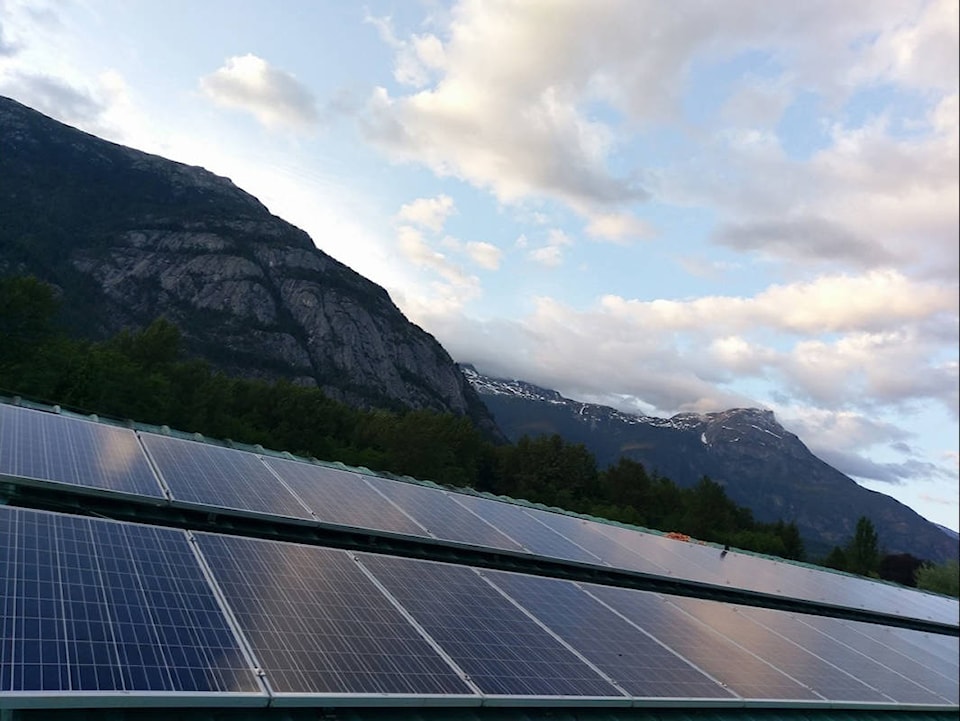One resident and one local business owner have made a huge shift in how they power their operations last week with the hook-up of two large solar power operations installed by Kelowna-based company Empower Energy.
The Hagensborg Shop Easy has installed 100 solar panels on their roof to reduce their energy consumption, and Leanna and Dick DeNeale of Saloompt have now hooked up their 60 panel solar system which will now provide all of the electricity needed to power their home.
Josh Persaud of Empower Energy was on hand at the DeNeale home to explain how the system works and answer questions from local residents who are interested in solar energy. While solar is gaining popularity as an alternative energy source, there are still some challenges associated with it, especially in rainy, coastal areas like Bella Coola.
Persaud said that despite those challenges it’s still a very effective way to power your business or home and, depending on the size and type of system, you can reduce or completely eliminate your dependence on BC Hydro.
“I always recommend that people start off with the most minimal system possible and don’t generate more power than they need,” said Persaud. “You can always expand later on.”
Persaud explained that the set-up at the DeNeale’s, which is currently hooked into the BC Hydro grid, is currently the most popular type of installation they do as it does not require batteries if the client prefers to avoid them.
“Batteries are still quite expensive, so many people are going this route and just hooking into the grid,” said Persaud. “There’s always the option to go completely off-grid with batteries later on.”
No batteries means there is no backup supplied by the system, so there is still reliance on BC Hydro if the system cannot power itself due to low light. On the other hand, excess energy produced by their system in longer daylight hours is returned to them as a credit on their bill for the winter months.
At present, Bella Coola is dependent on diesel generators to produce the bulk of its energy needs. In 2017, Bella Coola burned an average of 196,716 litres of diesel per month. The consumption varies widely depending on the time of year, but there is no time when the generator is not employed.
“Fuel consumption amounts change from year to year depending hydro generation at Clayton Falls, weather conditions, and how much power customers use,” said Bob Gammer, BC Hydro Manager, Northern Community Relations. “The lowest annual diesel consumption in the last five years was 1,731,535 litres in the fiscal year ended on March 31, 2015. In the 12 months ending March 31, 2017 consumption was 2.36 million litres, with a low of 64,000 litres in August and a high of 392,000 in December and January.”
Due to living in a “non-integrated area,” we do pay higher electricity rates than the rest of the province. Similar communities include Haida Gwaii, Atlin and Dease Lake, all of which also depend heavily on diesel although both Atlin and Dease Lake now also employ small hydro-electric operations to offset it whenever possible.
“Every customer in the province pays a basic charge per day. Bella Coola is considered Zone 2 and pays 20.86 cents per day compared to 19.50 cents per day in Zone 1,” said Gammer. “Your kilowatt per hour charges are 13.26 cents per day compared with Zone 1’s 8.84 cents per day, so those are slightly higher.”
The price really starts to rise, however, when people go above their Step 1 allotted kilowatt hours. In Zone 2 this is 1500kwh. When you exceed this threshold you start paying 18.20 cents per kilowatt hour; Zone 1 only pays 13.26 cents when they go above their threshold.
“The Zone 2 rate is noticeably higher, about 30 to 40 percent, once you go above that threshold,” said Gammer.
For many people going solar is less about a return on investment, which can take up to 25 years, and more about reducing their dependence on hydro grids or damaging fuel sources such as diesel, which is presently barged into our community from the lower mainland.
“If one or two homes or businesses go solar in Bella Coola we aren’t going to notice anything,” said Gammer. “However if a lot of people in the Valley make the switch that would certainly affect diesel consumption.”
A set-up like the DeNeale’s cost approximately $60,000, but costs can vary widely due to the location and onsite infrastructure available. Solar panels need to be installed at precise angles to be effective, and details like this can add or reduce the costs.
“An average installation is $10,000 to $25,000 for most homes,” said Persaud. “It would then take about 10 - 15 years to return that investment.”
Persaud also said that current provincial government policy isn’t helping to grow the industry, as there is little incentive for homeowners in the form of tax breaks or rebates for going solar other than a possible credit from BC Hydro.
Gammer said BC Hydro has no plans to expand the hydro power capacity at Clayton Falls or to expand hydro power generation at other sites in the Bella Coola area, but that they are conducting projects with alternative fuel sources in other communities.
“We are conducting a pilot project with LNG (liquified natural gas) in Anahim Lake right now,” said Gammer. “If it’s successful it may be expanded to other non-integrated communities in the future.”
